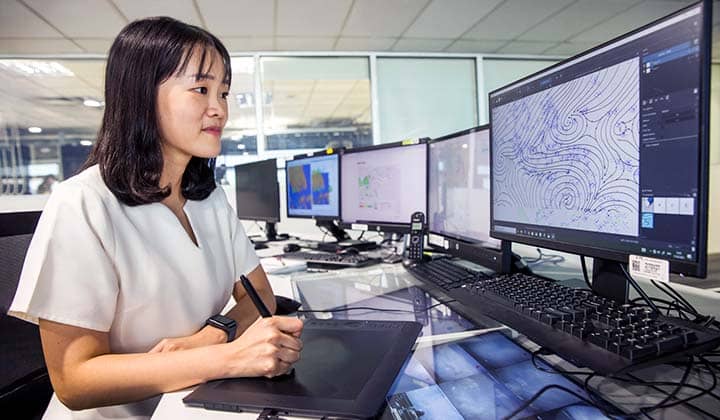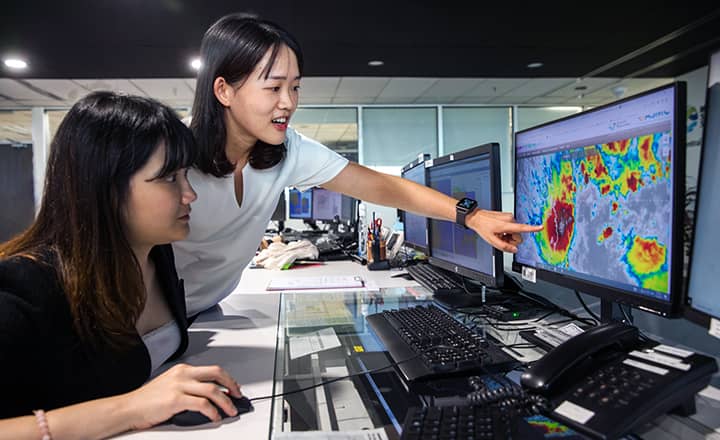Keeping A Watchful Eye On Our Weather

If you spot Leong Pei Yi gazing at the clouds, she’s not lost in a daydream. She is observing the clouds as part of her job at the Meteorological Service Singapore (MSS).
“Clouds first sparked my interest in meteorology with their various shapes and sizes,” says Pei Yi.
As a meteorologist, she analyses weather data to predict the coming weather, provides timely and reliable weather forecasts, and issues public advisories for adverse weather.

To make accurate forecasts, Pei Yi carefully studies a wide range of weather data, gathered from on-ground observation stations and meteorological observation systems like radars that scan the skies. She also relies on numerical weather prediction models to guide her forecasting.
During her ground observations, which she does to complement the various meteorological data, Pei Yi looks out for cumulonimbus clouds – dense, low clouds as tall as 15km, with water droplets frozen into ice at the top. If you see them, brace yourself. They are an ominous sign of impending thunderstorms.
The Impact of Weather Forecasting
Predicting thunderstorms is a crucial part of her work, as they affect critical sectors like aviation, construction and maritime. Thunderstorms can cause low visibility, strong winds, lightning risks and other conditions that affect operations.
In aviation, thunderstorms may require air traffic controllers to redirect flights for safety. Operators subscribe to weather forecasts, which are issued throughout the day, to schedule their flights effectively.
Pei Yi and her colleagues also issue weather warnings – typically within 15 minutes in advance – so that air traffic controllers can respond swiftly.
“[In Singapore,] thunderstorms typically develop, intensify and dissipate relatively quickly”, says Pei Yi. The dynamic nature of weather systems in the tropics is one challenge of predicting the weather here.
Although advances in numerical weather prediction models have led to improved forecasts, these models do not simulate tropical weather systems as well as they do for other regions.
To overcome this and improve Singapore’s forecasting capabilities, MSS’ Centre for Climate Research Singapore developed a local weather prediction model called “SINGV”, through a collaboration with the UK Meteorological Office.
With a higher spatial resolution of 1.5km to better model small-scale localised thunderstorms, forecasts in the tropics can be delivered with more precision.

Besides issuing weather forecasts, Pei Yi also monitors geophysical hazards such as earthquakes, tsunamis and volcanic eruptions, as well as transboundary smoke haze that may affect our surrounding region.
On important occasions like the National Day Parade, the MSS employs meteorologists on-site to assess the weather and provide weather advisories.
The final output for the weather forecast and advisories is channelled into the MSS website and is readily available at your fingertips via the myENV app.
Pursuing the Path of Meteorology
Meteorologists usually have a degree in meteorology or atmospheric sciences, but Pei Yi does not. Instead, she has a Bachelor’s degree in Environmental Engineering and used to work as an engineer in the private sector.
When she saw a vacancy for a meteorologist role at the MSS, Pei Yi leapt at the chance to explore a new area of work, undeterred by her lack of experience in the field.
To become an operational meteorologist, Pei Yi attended a training course organised by Australia’s Bureau of Meteorology over a period of about seven months. This was held online due to the COVID-19 pandemic. Upon completing the course, she continues to be trained on the job at MSS’ Central Forecast Office.
Besides formal qualifications, meteorologists also need to effectively communicate weather information and forecasts to stakeholders. Multi-tasking and quick decision-making are also valued skills that one should hone.

Forecasting in the Age of Climate Change
Pei Yi has spent only about a year in operational forecasting. “As someone who values contributing to society, I find great satisfaction in knowing that my forecasts help the public and stakeholders to plan and make better decisions,” says Pei Yi.
Understanding typical climate patterns usually gives Pei Yi a good gauge of how the weather could unfold at certain times of the year.
However, with the impact of climate change, weather forecasting has become more complex. “Weather patterns now vary, which could lead to more unexpected weather occurring,” Pei Yi explains.
When her forecasts turn out to be accurate, Pei Yi is delighted.
“But when it is not, I also enjoy the process of trying to figure out what went wrong and how I can do a better job next time,” she adds.
Thanks to meteorologists like Pei Yi who work day and night to provide weather advisories, we can enjoy our time outdoors safely.
- POSTED ON
Mar 21, 2023
- TEXT BY
Lei Ng
- PHOTOS BY
Norman Ng









